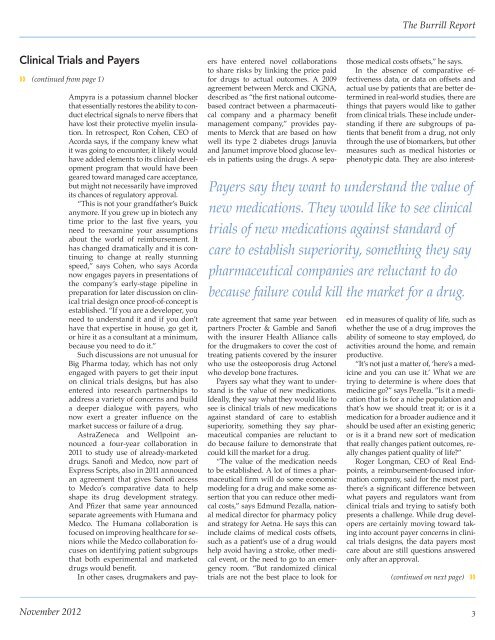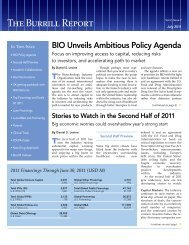Download Now - The Burrill Report
Download Now - The Burrill Report
Download Now - The Burrill Report
- No tags were found...
Create successful ePaper yourself
Turn your PDF publications into a flip-book with our unique Google optimized e-Paper software.
<strong>The</strong> <strong>Burrill</strong> <strong>Report</strong>Clinical Trials and Payers❱❱ (continued from page 1)Ampyra is a potassium channel blockerthat essentially restores the ability to conductelectrical signals to nerve fibers thathave lost their protective myelin insulation.In retrospect, Ron Cohen, CEO ofAcorda says, if the company knew whatit was going to encounter, it likely wouldhave added elements to its clinical developmentprogram that would have beengeared toward managed care acceptance,but might not necessarily have improvedits chances of regulatory approval.“This is not your grandfather’s Buickanymore. If you grew up in biotech anytime prior to the last five years, youneed to reexamine your assumptionsabout the world of reimbursement. Ithas changed dramatically and it is continuingto change at really stunningspeed,” says Cohen, who says Acordanow engages payers in presentations ofthe company’s early-stage pipeline inpreparation for later discussion on clinicaltrial design once proof-of-concept isestablished. “If you are a developer, youneed to understand it and if you don’thave that expertise in house, go get it,or hire it as a consultant at a minimum,because you need to do it.”Such discussions are not unusual forBig Pharma today, which has not onlyengaged with payers to get their inputon clinical trials designs, but has alsoentered into research partnerships toaddress a variety of concerns and builda deeper dialogue with payers, whonow exert a greater influence on themarket success or failure of a drug.AstraZeneca and Wellpoint announceda four-year collaboration in2011 to study use of already-marketeddrugs. Sanofi and Medco, now part ofExpress Scripts, also in 2011 announcedan agreement that gives Sanofi accessto Medco’s comparative data to helpshape its drug development strategy.And Pfizer that same year announcedseparate agreements with Humana andMedco. <strong>The</strong> Humana collaboration isfocused on improving healthcare for seniorswhile the Medco collaboration focuseson identifying patient subgroupsthat both experimental and marketeddrugs would benefit.In other cases, drugmakers and payershave entered novel collaborationsto share risks by linking the price paidfor drugs to actual outcomes. A 2009agreement between Merck and CIGNA,described as “the first national outcomebasedcontract between a pharmaceuticalcompany and a pharmacy benefitmanagement company,” provides paymentsto Merck that are based on howwell its type 2 diabetes drugs Januviaand Janumet improve blood glucose levelsin patients using the drugs. A separateagreement that same year betweenpartners Procter & Gamble and Sanofiwith the insurer Health Alliance callsfor the drugmakers to cover the cost oftreating patients covered by the insurerwho use the osteoporosis drug Actonelwho develop bone fractures.Payers say what they want to understandis the value of new medications.Ideally, they say what they would like tosee is clinical trials of new medicationsagainst standard of care to establishsuperiority, something they say pharmaceuticalcompanies are reluctant todo because failure to demonstrate thatcould kill the market for a drug.“<strong>The</strong> value of the medication needsto be established. A lot of times a pharmaceuticalfirm will do some economicmodeling for a drug and make some assertionthat you can reduce other medicalcosts,” says Edmund Pezalla, nationalmedical director for pharmacy policyand strategy for Aetna. He says this caninclude claims of medical costs offsets,such as a patient’s use of a drug wouldhelp avoid having a stroke, other medicalevent, or the need to go to an emergencyroom. “But randomized clinicaltrials are not the best place to look forPayers say they want to understand the value ofnew medications. <strong>The</strong>y would like to see clinicaltrials of new medications against standard ofcare to establish superiority, something they saypharmaceutical companies are reluctant to dobecause failure could kill the market for a drug.those medical costs offsets,” he says.In the absence of comparative effectivenessdata, or data on offsets andactual use by patients that are better determinedin real-world studies, there arethings that payers would like to gatherfrom clinical trials. <strong>The</strong>se include understandingif there are subgroups of patientsthat benefit from a drug, not onlythrough the use of biomarkers, but othermeasures such as medical histories orphenotypic data. <strong>The</strong>y are also interestedin measures of quality of life, such aswhether the use of a drug improves theability of someone to stay employed, doactivities around the home, and remainproductive.“It’s not just a matter of, ‘here’s a medicineand you can use it.’ What we aretrying to determine is where does thatmedicine go?” says Pezella. “Is it a medicationthat is for a niche population andthat’s how we should treat it; or is it amedication for a broader audience and itshould be used after an existing generic;or is it a brand new sort of medicationthat really changes patient outcomes, reallychanges patient quality of life?”Roger Longman, CEO of Real Endpoints,a reimbursement-focused informationcompany, said for the most part,there’s a significant difference betweenwhat payers and regulators want fromclinical trials and trying to satisfy bothpresents a challenge. While drug developersare certainly moving toward takinginto account payer concerns in clinicaltrials designs, the data payers mostcare about are still questions answeredonly after an approval.(continued on next page) ❱❱November 2012 3












